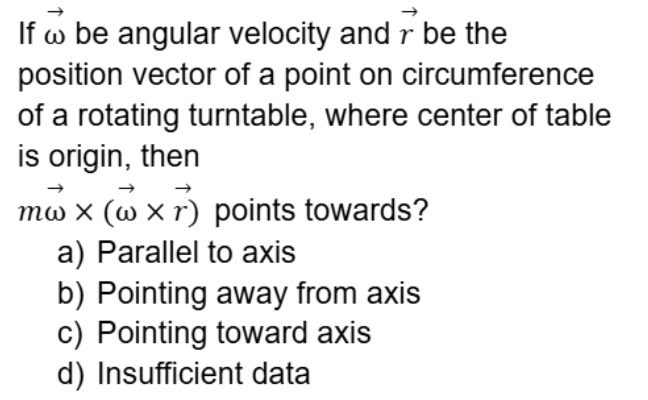Question
Question: If $\overrightarrow{\omega}$ be angular velocity and $\overrightarrow{r}$ be the position vector of ...
If ω be angular velocity and r be the position vector of a point on circumference of a rotating turntable, where center of table is origin, then
mω×(ω×r) points towards?

Parallel to axis
Pointing away from axis
Pointing toward axis
Insufficient data
Pointing toward axis
Solution
To determine the direction of the vector mω×(ω×r), we can use the vector triple product identity:
A×(B×C)=B(A⋅C)−C(A⋅B)
In our case, let A=ω, B=ω, and C=r. So, the expression inside the bracket becomes:
ω×(ω×r)=ω(ω⋅r)−r(ω⋅ω)
Now, let's analyze the terms:
-
ω⋅ω: This is the dot product of the angular velocity vector with itself, which equals the square of its magnitude, ω2.
ω⋅ω=∣ω∣2=ω2.
-
ω⋅r: This is the dot product of the angular velocity vector and the position vector. The problem states that ω is the angular velocity of a rotating turntable, and r is the position vector of a point on its circumference, with the center of the table as the origin. For a turntable rotating about an axis passing through its center, the angular velocity vector ω is directed along the axis of rotation. The position vector r of a point on the circumference, measured from the center (origin), lies in the plane of the turntable and is therefore perpendicular to the axis of rotation. Since ω is parallel to the axis and r is perpendicular to the axis, ω and r are perpendicular to each other. Therefore, their dot product is zero: ω⋅r=0.
Substitute these results back into the vector triple product expression:
ω×(ω×r)=ω(0)−r(ω2) ω×(ω×r)=−ω2r
Finally, multiply by m:
mω×(ω×r)=m(−ω2r) mω×(ω×r)=−mω2r
Interpretation of the result:
The vector r points from the origin (center of the turntable) to the point on the circumference. The vector −r therefore points from the point on the circumference directly towards the origin. Since the origin is the center of the turntable and lies on the axis of rotation, the vector −mω2r points towards the axis of rotation.
This vector represents the centripetal force acting on the particle of mass m. Centripetal force is always directed towards the center of the circular path, which in this case is the center of the turntable (on the axis of rotation).
